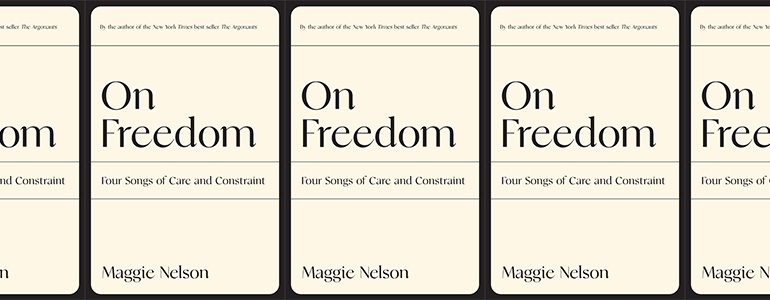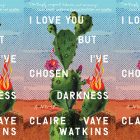Maggie Nelson’s Complication of Freedom

The thoughtful, hybrid style, mixing the personal and theoretical, that characterized Maggie Nelson’s earlier books—such as The Red Parts: Autobiography of a Trial (2007) and The Argonauts (2015)—continues in On Freedom: Four Songs of Care and Constraint, published last year. The book, she tells us, grew out of a desire to understand freedom; it came from questions that arose as “an unexpected subtext” to her 2011 book, The Art of Cruelty: A Reckoning, which considered representations of cruelty and violence in art. “I had set out to write about cruelty,” she writes in the introduction, “then found, to my surprise, freedom coming through the cracks, light and air into cruelty’s stuffy cell.”
This allusion to prison confinement gives a hint to how Nelson approaches her consideration of freedom. On Freedom is divided into four “Songs of Care and Constraint” titled, in order, “Art Song,” “The Ballad of Sexual Optimism,” “Drug Fugue,” and “Riding the Blinds,” with each section considering freedom in the contexts of art and appropriation, sexual freedom and the #MeToo movement, addiction, and climate change, respectively. Freedom, of course, is what is typically taken away from a person as a (rather unimaginative) punishment whenever one is convicted of a serious crime; that person is confined to a prison. How freedom is considered apart from constraint, and that binary notion of freedom and being constrained—and Nelson’s argument in favor of rejecting it—informs much of On Freedom. “Thankfully,” she writes, “acting as if the world neatly divides (or that our task is to divide it) into problematic, ethically turbulent, essentially dangerous people who should stay ‘over there,’ and nonproblematic, ethically good, essentially safe people who should be allowed to stay ‘over here,’ is not our only option. After all, what I’ve just described is a prison.”
“Can you think of a more depleted, imprecise, or weaponized word?” writes Nelson in the introduction, on freedom. One can easily point to so many instances of that weaponization, enacted frequently by the right wing—like the childish renaming of French fries as “Freedom fries” in 2003, when French officials criticized the U.S. invasion of Iraq. Nelson’s book comes at a time when the “freedom rally”—truckers driving in convoys to block roadways in protest, ostensibly, of mask mandates during the COVID-19 pandemic—feels like a reduction of the idea of freedom to a commodity measured out in physical spaces to be occupied. Like those caught in a war zone or random shooting spree, those who are vulnerable or conscientious of infection are, in the presence of anti-maskers, made less free—forced to hide to remain safe. It’s not uncommon now for public figures who get criticized for their comments or actions to be the first to call themselves victims of cancel culture, insisting that their free speech rights were violated—though, interestingly, nobody stopped them from saying what they said.
Freedom is, in fact, more complicated in definition than how the right attempts to portray it, as it is contemplated with respect to both positive and negative space—we speak of a freedom to do something as well as a freedom from something, and often ignore that in doing so we are talking about disparate, nearly antithetical ideas. Part of the reason that many Americans’ concept of freedom has become so narrowed might be that we have conflated the word with an idea of liberation—a momentary act of springing one from a constraint (from territorial oversight or bondage) rather than as something to be practiced and sustained. Nelson points to Michel Foucault’s distinction between the momentary act of freedom and its ongoing practice: “Liberation paves the way for new power relationships, which must be controlled by practices of freedom.”
Here is a way that Nelson comes to identify and appreciate freedom’s paradox—that true freedom comes with an understanding of limits, or an appreciation of the idea of constraint. In terms of art—explored in her first chapter—understanding the limits of what art can do, how well we express ourselves, and the knowledge that deeper engagement occurs with an understanding of other people’s situations and points of view helps us communicate. She quotes the philosopher Brian Massumi: “Freedom always arises from constraint—it’s a creative conversion of it, not some utopian escape from it.”
Throughout, On Freedom attempts to widen the channels of what freedom means like this—particularly freedom of expression. “The Ballad of Sexual Optimism” considers freedom by attempting to do away with diametrically opposed notions—not just the negative-space notions of how one can walk free from harassment, from being groped and having one’s space and body reduced, but also sexuality as a freedom to express. Reducing our sexual personae only helps to reward our culture of shaming, Nelson believes, and to reduce outwardly sexual expression to personality quirks that get labelled as transgressive kink. We are more liberated when we are more aware of the spaces in which we exist, when we are able to “accept our motley selves, sexual and otherwise” within those spaces.
The chapter on addiction, “Drug Fugue,” works in a similar way to challenge our common notion of substance use disorder as a surrendering of agency. Addiction has often been expressed as a metaphorical prison, lending itself naturally to confining language—one is “hooked” on a drug, tries to “get off” the drug, tries to “get clean,” and Nelson devotes the bulk of this chapter to analyzing how other writers, including Iris Owens and Ellen Miller, have treated addiction, noting a literary culture of giving substances their own agency: “The frequency with which drugs come alive in drug writing invites us to consider whether drugs are alive, or something other than inert matter—perhaps related to what the ecological theorist Timothy Morton calls ‘nonhuman people.’” Nelson says that it is a mistake to think of addiction as a substitute for human connection; rather, addiction “reveals our porousness to nonhuman people—our appetite for and vulnerability to them”; sobriety ends up becoming “a form of mourning, insofar as it requires letting go of forms of coping that one previously felt unable to go on without.” There is a value in discerning between “forms of abandonment that vitalize and those that thwart,” Nelson believes, and we aren’t in a place to assume that one who pursues pleasure, chemically or otherwise, is not living purely in doing so. A purer freedom is found not by detaching oneself from a dependency but by living fully through it—the creative conversion of restraint that Massumi preached.
Nelson explains in the introduction to On Freedom that her ambition for the book is to imagine “a freedom rooted in a ‘we’ rather than an ‘I.’” Of the four “songs,” the final one, “Riding the Blinds,” indulges this idea most fully. It often seems that any sense of individual agency we might be able to exercise with regard to the constrictions of climate feel like mere sops to the notion. Think of the insultingly banal micro-options we are given, from compostable drinking straws to reusable shopping bags, while multinational corporations continue to damage the planet on a massive scale with impunity. Yet even as that disparity resides in our consciences, our knowledge of the damage to which our single actions contribute hamstrings us with guilt and a sense of despair.
Nelson thinks that we have a habit of trying to engage with the climate crisis narratively, thinking of climate catastrophe as an inevitable doom result of actions that are taking place in the present—a then that is coming if individuals don’t do something now. We explain the micro-cautions we take in the present as acts of care for future generations. It’s a natural response to want to use what agency we think we have to stop the train as it races toward the bombed-out bridge. For Nelson, though, wariness of such an undefined threat acts as a constraint, while living free is “riding the blinds,” a phrase borrowed from the practice of riding between cars on a freight train so the authorities can’t see you—riding the blinds also means you can’t see where the train is going. With regard to our climate’s future, riding the blinds means accepting our inability to know what the end result will be, and simply engaging more actively with the present.
“Riding the Blinds,” as well as the three previous chapters, feels like an attempt at letting go of any wish to do something about those forces you cannot control. And while I suppose that is the point, as a reader it leaves me unsettled that so much of Nelson’s concept of freedom resides in bargaining. This doesn’t feel like a freedom rooted in a “we” so much as in one “I” giving in to another. Whenever one person’s freedom is compromised, it’s typically due to the actions of some outside force—an oppressor, a censor, an abuser, a polluting corporation, a government enacting centuries of negligence. To this point, in “Art Song” Nelson paraphrases the psychologist Adam Phillips: “The response to ‘you must listen to me’ or ‘you must care for me’ or ‘you must respond to me’—whether you’re addressing an artist, an institution, your lover, your child, or your representative in Congress—can always be ‘no’ … For once we truly acknowledge that there are other people in the world—which is harder to do than it sounds—we must reckon with the fact that we cannot control them, even as we depend upon them.” If we could control the forces out to deny us freedom, we would be complicit in tyranny.



